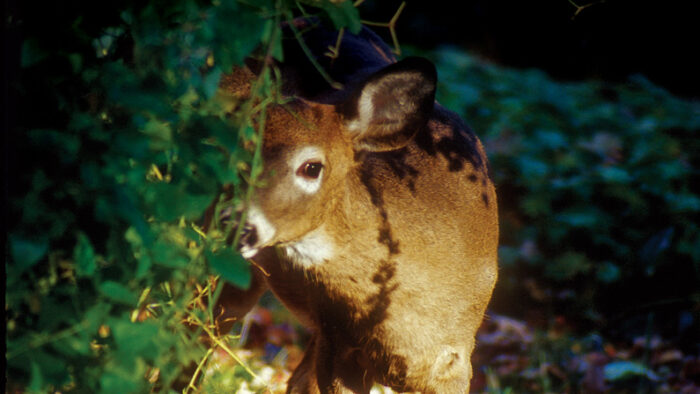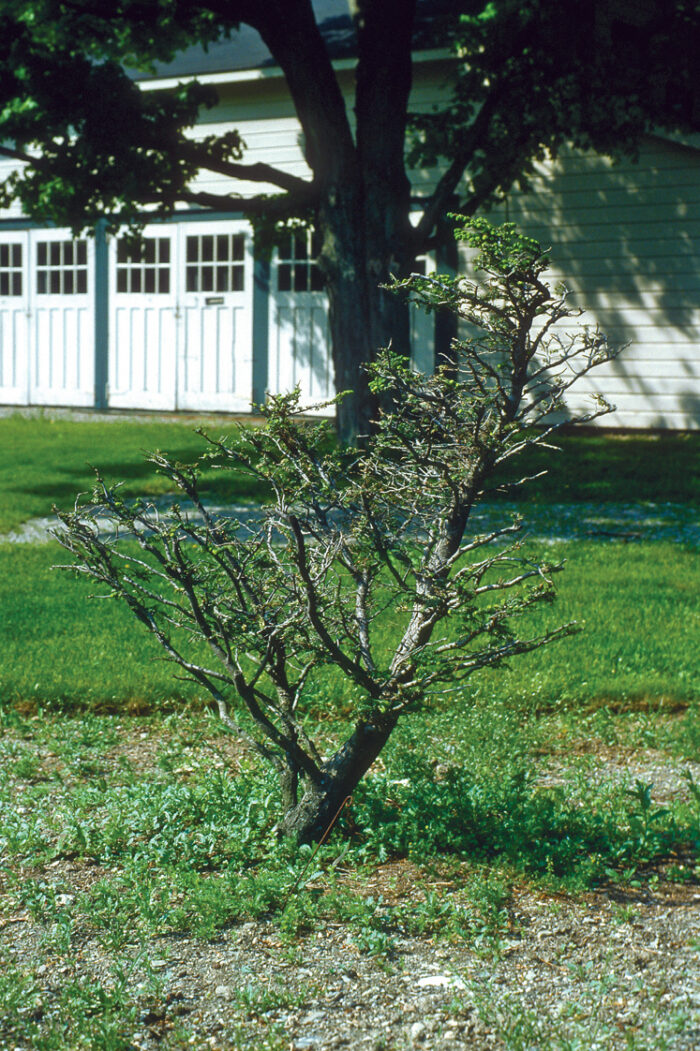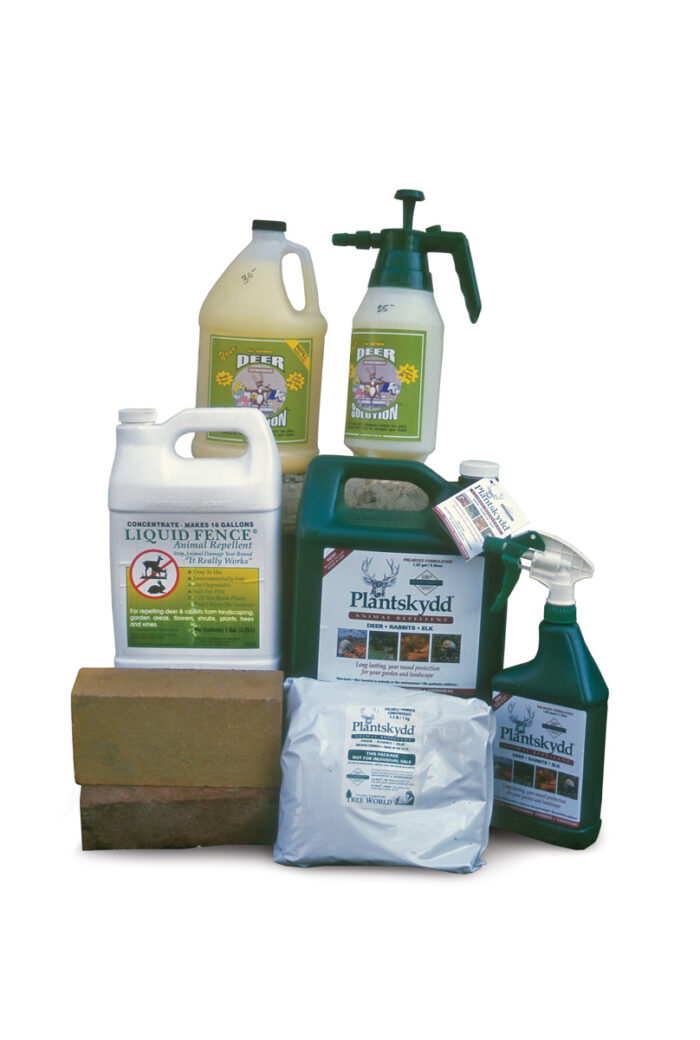
Most gardeners consider the term “deer” a four-letter word. If your garden hasn’t been mowed down by these unabashed creatures, you most likely know someone whose garden has. Deer populations are at an all-time high, especially where I live in the Northeast. It is estimated that there are more than three million white-tailed deer in this area alone, up from 600,000 in 1983. Before Europeans settled in this country, deer-herd densities averaged 6 to 10 deer per square mile. Today, some suburban deer-herd densities are approaching 200 deer per square mile, drastically changing the flora of cultivated and natural settings and altering vital ecosystems.

There are a number of strategies to deter browsing, from “deerproof” plants to electric fencing. They are most often effective when used with one another. But the most widely appealing method of control seems to be spray-on deer repellents. Commonly found in garden and home centers, these products are based on odor or taste or a combination of the two.
Because deer rely heavily on their sense of smell as their first warning against danger, odor-based repellents are designed to send up a red flag. These types of products contain strong-scented ingredients, like soap, putrefied eggs, garlic, bone tar, or the urine of a deer predator, like that of
coyotes or bobcats. A number of odor-based repellents—such as soap sachets, processed sewage, mothballs, fabric-softener sheets, and blood meal—can be distributed around the area you wish to protect rather than sprayed on the plants.
Taste-based repellents are also effective. They’re usually sprayed on leaves to make a potential food source unpalatable. These repellents commonly include hot sauces, eggs, the fungicide thiram, and denatonium benzoate or Bitrex (the bitter product added to many household items to deter young children from consuming them). Some of these repellents come in systemic forms, which are sprayed on a plant or added to the soil at planting time.
I’ve been evaluating repellents for many years, and I’ve discovered that there is no clear-cut answer as to which one works best. Virtually all the products I’ve tested will work well some years and fail miserably in others. The effectiveness of repellents—or, for that matter, any deer-control method—depends on many factors: The number of deer browsing in your garden, the location of other preferred food sources, temperature, snow cover (both duration and depth), and the abundance and quality of grasses and forbs during the growing season and of mast (nuts of forest trees, such as acorns) in fall influence the browsing behavior of deer.
I advise gardeners to become “environmental forecasters” and to create a customized plant-protection program for their plants (sidebar, right). Note the relationships between wildlife and their habitat, and learn what measures need to be taken when biological and environmental factors change. Some of the most severe browsing occurs, for example, in the mid- to late- summer months during years of drought, when deer target the soft, succulent growth on many shrubs and perennials.
I’ve likewise observed minimal early- and midwinter browsing on woody plants when we have good masting years. When devising my deer-protection strategies, I always take factors like these into account and respond accordingly.
A practical program for combatting deer
Despite our best efforts, deer damage plantings. The two questions most frequently asked are: “What can I plant that deer won’t eat?” and “How can I stop deer from browsing on my plants?” Well, if I had the answers, I’d probably be a horticultural legend. The simple answers are that there are few plants that are truly deerproof and that, if deer are hungry enough, repellents, scare devices, and poorly constructed physical barriers will fail. Over the years, however, I have developed a program that helps in the fight against deer. With diligence and a mix of strategies, you can achieve a “more-than-just-bare-stems” look for your landscape.
Early spring: Hang sachets filled with Milorganite fertilizer around the area, or apply Milorganite (at half the recommended rate) around emerging bulbs and spring ephemerals. Reapply a month later. Applications of liquid foliar fertilizers/repellents, like Bobbex, work well; just don’t apply them in late summer or fall.
Late spring/summer: Apply spray repellents every three to four weeks once plants have fully leafed out. Spritz flower buds as they appear with an egg-based product, like Deer Off; systemic products are not taken up by flower buds. Deer Stopper is a good alternative, or you can make your own repellent; mix and spray the following ingredients every 10 days: 1 egg, ½ cup whole milk, 1 tablespoon cooking oil, 1 tablespoon liquid soap, and 1 gallon water.
Late summer/fall: Continue your summer program. Evaluate environmental and biological factors (like the abundance of food sources or an increase in the deer population) to determine if you should rely on repellents or physical barriers, like fencing or burlap wraps, for the winter months.
Winter: Apply a blood-derived spray repellent, like Plantskydd, during the dormant season (once in November and again in January). Odor- or taste-based repellents can be less effective in cold temperatures. Repellents containing thiram, like Bonide Deer and Rabbit Repellent, will also work; just be sure to add an adhesive, like Vapor Gard, because thiram does not withstand weather well.
—Brad Roeller is the display garden and grounds manager at the Institute of Ecosystem Studies in Millbrook, New York, where he has been studying deer behavior for the past 20 years.

















Comments
Thanks for the info. It is a love/hate relationship. This spring I had a doe with triplets! She was beautiful and bold and her fawns ate whatever they wanted:). I put up ugly borders around some of my false cypress which were devastated by them. They are still somewhat small and I am trying a more aesthetic portable fence, will see. It was a bumper acorn crop so I am waiting to see. She did eat ALL the buds (except for one) off of my vanilla strawberry hydrangea. It is part of living on the edge of woods. Going forward I do look for plants that deer do not like. But when they are hungry that plant doesn't exist. You just have to share.
Log in or create an account to post a comment.
Sign up Log in